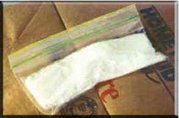PALO ALTO, Calif., Nov. 22 /PRNewswire/ -- Jazz Pharmaceuticals announced today that Xyrem(R) (sodium oxybate) oral solution has been approved for marketing by the U.S. Food and Drug Administration (FDA) to treat excessive daytime sleepiness (EDS) in patients with narcolepsy.
Xyrem was approved by the FDA in October 2002 as the first and only treatment for cataplexy in patients with narcolepsy. The expanded indication for use in treating excessive daytime sleepiness is "good news for narcolepsy patients," according to Richard Bogan, M.D., Assistant Clinical Professor, University of South Carolina School of Medicine. Dr. Bogan, who was an investigator in the clinical studies for Xyrem, said that "Xyrem has shown important clinical benefits in the treatment of EDS and cataplexy, the key symptoms of narcolepsy."
The effectiveness of sodium oxybate for the treatment of narcolepsy symptoms was established in four multi-center, randomized, double-blind, placebo-controlled, studied over a period of time between 4 and 8 weeks. The studies examined three dosages of sodium oxybate (4.5g per night, 6g per night and 9g per night) taken in two equally divided doses (the first at bedtime and the second 2.5 to 4 hours later).
Two well-controlled clinical trials demonstrated that sodium oxybate at doses of 6g and 9g per night is effective at subjectively (as measured by the Epworth Sleepiness Scale) and objectively (as measured by the Maintenance of Wakefulness Test) improving excessive daytime sleepiness. The Epworth Sleepiness Scale evaluates the extent of sleepiness in everyday situations by asking patients a series of questions. The Maintenance of Wakefulness Test measures latency to sleep onset when patients are placed in a relaxed atmosphere and asked to remain awake without using extraordinary measures. In addition, two well-controlled clinical trials demonstrated that all dosages of sodium oxybate significantly reduced the frequency of cataplexy attacks. Furthermore, patients on the 6g or 9g per night doses saw significant improvements in quality of life -- with the majority of them rating much or very much improved on the Clinical Global Impression of Change (CGI-C) in Day and Nighttime Symptoms scale.
Xyrem was generally well tolerated and no treatment-related serious adverse events were reported. The most commonly reported adverse events (greater than or equal to 5%) in placebo controlled clinical trials associated with the use of sodium oxybate and occurring more frequently than seen in placebo-treated patients were: nausea (19%), dizziness (18%), headache (18%), vomiting (8%), somnolence (6%), urinary incontinence (6%), and nasopharyngitis (6%). These incidences are based on combined data from three well-controlled clinical trials and two smaller randomized, double-blind, placebo-controlled, cross-over trials (n=655).
"We are very pleased that the data from these studies show nightly Xyrem therapy reduces excessive daytime sleepiness and cataplexy in patients suffering from narcolepsy," said Phil Perera, M.D., Chief Medical Officer of Jazz Pharmaceuticals.
About Narcolepsy
Narcolepsy is a chronic, debilitating neurological disease, the primary symptoms of which are excessive daytime sleepiness, fragmented nighttime sleep, and cataplexy. The hallmark symptom of narcolepsy is excessive and overwhelming daytime sleepiness, even after nighttime sleep. EDS is present in 100% of narcolepsy patients and it causes people to become drowsy or fall asleep, often at inappropriate times and places. Cataplexy, the sudden loss of muscle tone, is the most predictive symptom of narcolepsy. Cataplexy can range from slight weakness or a drooping of the face to the complete loss of muscle tone and is triggered by strong emotional reactions such as laughter, anger or surprise.
More than 150,000 Americans are afflicted by narcolepsy, but fewer than 50,000 are diagnosed. Narcolepsy is as widespread as Parkinson's Disease or multiple sclerosis and more prevalent than cystic fibrosis, but it is less well known. Narcolepsy is often mistaken for depression, epilepsy, or the side effects of medications.
About Xyrem
Xyrem is marketed by Jazz Pharmaceuticals through its wholly-owned subsidiary, Orphan Medical.
Sodium oxybate, the active ingredient in Xyrem, is a sodium salt of gamma- hydroxybutyrate (GHB). GHB is a substance with a history of abuse when acquired illicitly and used illegally. Abuse of illicit GHB has been associated with adverse CNS events including seizures, respiratory depression and profound decreases in level of consciousness, with instances of coma and death.
Xyrem is a Schedule III drug under the Controlled Substances Act and is only available through a restricted distribution system called the Xyrem Success Program(R). Please refer to the Xyrem package insert ( http://www.xyrem.com/ ) for full prescribing information.
About Jazz Pharmaceuticals, Inc.
Jazz Pharmaceuticals is focused on helping patients by meeting unmet medical needs in neurology and psychiatry with important and innovative therapeutic products. Jazz Pharmaceuticals is aggressively building its product portfolio through a combination of commercialization and development activities. Based in Palo Alto, California, the company is committed to working closely with patients, patient advocacy groups and healthcare professionals. Jazz Pharmaceuticals acquired Orphan Medical in 2005. For further information, please visit http://www.jazzpharmaceuticals.com/ .
CONTACT: Mark Leonard, +1-847-267-9660, markdleonard@comcast.net , or Matthew Fust of Jazz Pharmaceuticals, Inc., +1-650-496-3777, mediainfo@jazzpharma.com
Web site: http://www.jazzpharmaceuticals.com/ http://www.xyrem.com/
COPYRIGHT 2005 PR Newswire Association LLC
COPYRIGHT 2005 Gale Group



